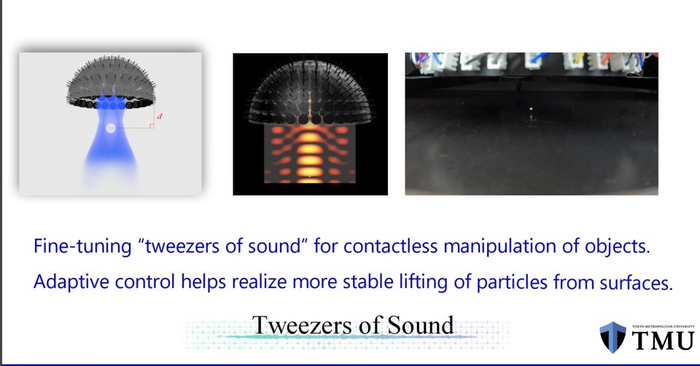Tokyo, Japan – Researchers from Tokyo Metropolitan University have successfully enhanced technology to lift small particles using sound waves. Their “acoustic tweezers” could already lift things from reflective surfaces without physical contact, but stability remained an issue. Now, using an adaptive algorithm to fine-tune how the tweezers are controlled, they have drastically improved how stably the particles can be lifted. With further miniaturization, this technology could be deployed in a vast range of environments, including space.

Credit: Tokyo Metropolitan University
Tokyo, Japan – Researchers from Tokyo Metropolitan University have successfully enhanced technology to lift small particles using sound waves. Their “acoustic tweezers” could already lift things from reflective surfaces without physical contact, but stability remained an issue. Now, using an adaptive algorithm to fine-tune how the tweezers are controlled, they have drastically improved how stably the particles can be lifted. With further miniaturization, this technology could be deployed in a vast range of environments, including space.
(For the full video, visit https://youtu.be/PoZsKjst82g)
As anyone standing next to a loudspeaker can attest to, sound waves can exert a real, physical force. With the right arrangement of “speakers” at the right frequency, amplitude, and phase, it becomes possible to superimpose those waves and setup a field of influence which can push, lift and hold physical objects. Such “acoustic tweezer” technology promises completely contactless, contamination-free manipulation of small objects.
Last year, Dr Shota Kondo and Associate Professor Kan Okubo from Tokyo Metropolitan University realized contactless lift and movement of millimeter-sized particles using a hemispherical array of small, ultrasound transducers. The transducers would be driven individually according to a unique algorithm, allowing them to set up fields of sound pressure which ultimately lifted and moved objects. However, the stability of their “acoustic tweezers” remained an outstanding issue.
Now, the same team have come up with a way of using the same setup to achieve significant enhancements in how they can lift particles from rigid surfaces. There are two “modes” in which the transducers can be driven, where opposing halves of their hemispherical array are driven in and out of phase. The team’s new insight is that different modes are more suited to doing certain things. Starting with a particle on a surface, an “in-phase” excitation mode is better at lifting and moving the particle close to the surface, with accurate targeting of individual particles only a centimeter apart. Meanwhile, an “out-of-phase” mode is more suited to bringing the lifted particle into the center of the array. Thus, using an adaptive switching between the modes, they can now leverage the best of both modes and achieve a well-controlled, stable lift, as well as more stability inside the trap once it is lifted.
This is an important step forward for a futuristic technology that could one day be deployed to manipulate samples which need to be kept strictly contamination free. The team also hopes that it might find practical application in space one day, where competing against gravity is not an issue.
This work was partially funded by the Murata Science Foundation.
Journal
Japanese Journal of Applied Physics
DOI
10.35848/1347-4065/ac51c4
Article Title
Improved mid-air acoustic tweezers using adaptive phase and amplitude control
Article Publication Date
10-Jun-2022




